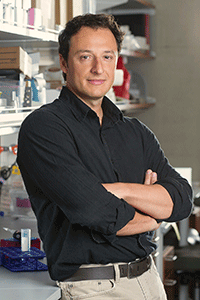Scientists Discover That Areas Regulating Genes Contribute to Autism’s Cause
Scientists Discover That Areas Regulating Genes Contribute to Autism’s Cause

The genetic factors contributing to autism are notoriously hard to understand. One reason is that only a fraction of the total set of DNA mutations thought likely to play a role in the illness have so far been identified. Genome experts have estimated that at least 300 and perhaps as many as 1000 of the 20,000 human genes may play a role—in different combinations—in different affected individuals.
Progress in piecing together this scientific puzzle often involves discovering something new and important, yet something that actually adds complexity to the puzzle. Such is the case with an important new discovery published in Science on April 20, 2018. A team led by 2010 Independent Investigator Jonathan Sebat, Ph.D., of the University of California, San Diego and including Alysson R. Muotri, Ph.D., a 2014 Young Investigator, who directs a laboratory in the same institution, has discovered areas of human DNA involved in autism’s cause that don’t “spell out” genes, but rather the regulatory areas that determine when specific genes are turned on and off. In other words, now we know that both genes and the DNA elements that control them are involved autism.
The team’s total dataset included whole-genome sequences of 9,274 people from 2,600 families affected by Autism Spectrum Disorder. Some of the regulatory sequences of DNA the team has identified are specifically associated with controlling a subset of genes that prior research has identified as being especially “intolerant” when they suffer mutations. By intolerant, scientists mean that these genes are particularly vulnerable when errors appear in their sequence. This can be true for various reasons – for instance, where the gene sits on a particular chromosome; or because the role it plays in brain development is absolutely essential.
One of the team’s discoveries pertains to the relationship between previously identified and rare mutations called “de novo,” or “new” mutations. Such DNA errors are not inherited from either parent; rather, they are new to a child and aren’t seen in other children of the same parents. The team noted that some of the mutations in regulatory regions occurred in areas that help control some of these “mutation-intolerant” genes.
Interestingly, however, all of the regulatory mutations the team spotted in affected children happened to be inherited, in most instances from the father, and were not present in other siblings. This is a still unexplained aspect of the new findings, Dr. Sebat and his team says. The difficult work of unscrambling the difficult puzzle continues in his lab and others across the world.



